Wildlife Hazards
Text and photos by Rick SpitzerThe wildlife around us encounter many hazards. Most are...

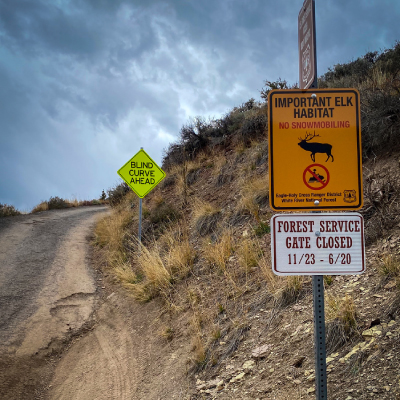
Read this article in Spanish here.
What a spectacular area we live in. Recreational opportunities abound and we do not have to travel far to enjoy beautiful scenery, areas of solitude, wildlife, meadows of flowers, streams, and rivers. But there is a catch. A lot of us take advantage of those opportunities, and that can become a problem.
All of us have had the experience of traveling to an area to hike, bike, fish, x-country ski, snowshoe, ride a snow machine, or travel in a 4 x 4 and find a closed gate, blocked parking lots, or closure signs. Why was this area closed? Why now? When will it reopen? Will it reopen?
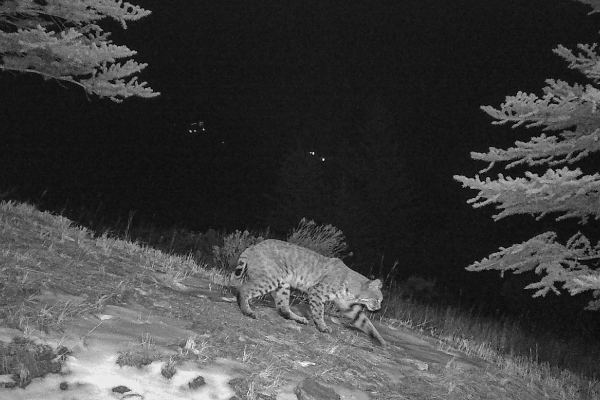
Trailcams can help researchers understand what wildlife is using a specific area, but also what humans are doing there.
We may not know the issues involved in this location. We rationalize that one person, like me, cannot be the problem here. We know how to be safe. We won’t interfere with the wildlife. We will not damage the environment. The problem often is that we are one of hundreds. As Pogo said, “We Have Met the Enemy and He Is Us”
Local area managers (town, county, state, Colorado Parks and Wildlife, United States Forest Service, Bureau of Land Management, National Park Service, and even private landowners) have many reasons for closing trails or areas under their management.
They may be taking action for any of these reasons.
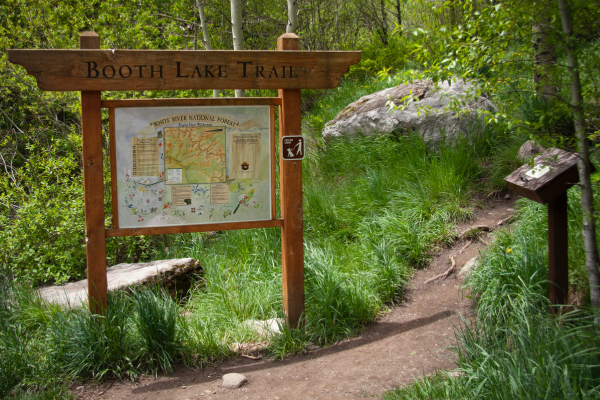 Trailheads have signs that have information about protected resources, hazards, and closures.
Trailheads have signs that have information about protected resources, hazards, and closures.
Private Landowners have a right to decide how their land is used. They may have had a small social trail that crossed their land that was used by a few of their neighbors. Their neighborhood has grown and more and more people use the trail. Some of these people leave trash, dog waste, and become a nuisance, forcing the landowner to block access.
Seasonal Closures often occur in the winter and spring to protect wildlife. Most wildlife requires minimal human disturbance to nest successfully, rear young, or obtain enough calories just to survive the cold of winter. An interruption in their needs may be directly harmful to the animals needs or in the ability to survive and reproduce.
Research has shown that elk calves may not obtain the nourishment they need when there is a human induced disturbance that causes the mother to be malnourished and cannot produce enough milk for calves. The research also showed that the human impact was enough that it could reduce the herd's ability to sustain itself. In addition, disturbed calves may be prone to separation from the adults and be more susceptible to predation. These areas are often opened after a certain date because the wildlife moves to other areas.
Some areas are closed for hunting by permitted and licensed hunters during specific times to provide greater safety and hunting success at specific times of the year.
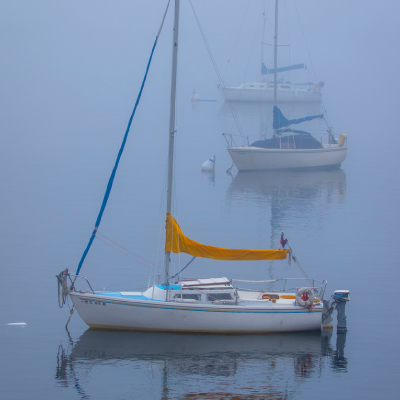 Boats that are trailered from one lake to another, may transfer zebra mussels to other locations.
Boats that are trailered from one lake to another, may transfer zebra mussels to other locations.
Sensitive Area Closures may be applied to open space areas that contain unique or sensitive vegetation. The alpine tundra around parking areas, trail heads and highly used trails to some mountain peaks are an example of sensitive vegetation. This demonstrates the need to protect specific natural resources. Sensitive Area Closures may also occur to ensure that birds of prey (raptors) will be undisturbed during their breeding and nesting seasons or that animals that give birth to young in that area will be able to raise them during that animal’s most perilous time.
Introduction of Invasive Species may be a significant issue in some areas. A good example is the spread of zebra and Quagga mussels in the rivers and lakes in Colorado. They are used as bait, food, and aquarium pets. But they often hitch rides on the boats, trailers, and equipment that people transport from place to place. These mussels invade bodies of water and can reproduce and spread to new waters rapidly. They may clog water systems. Once established they are difficult or impossible to eradicate. If proper cleaning of boats does not stop the spread, it may be necessary to close the waters.
Trail Closures may occur when resource damage has occurred, restoration, or relocation is underway, or conditions are deemed unsafe. All of us that use the trails have found areas where people shortcut switchbacks or wander off an eroded trail. Braided trails are often a result. Early season use by all types of travel can cause serious damage to some trails because of muddy areas and snow drifts people avoid.
Even snow machines can have an impact on trails. When there is insufficient snowpack, the trail is no longer suitable for use by snowmobiles; both with respect to damage to snowmobile equipment and the sustainability of the trail.
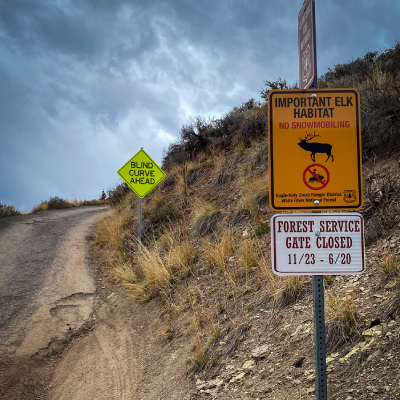 Signs often mark trails, roads, and areas as a habitat closure to protect species that use that area at specific times of the year.
Signs often mark trails, roads, and areas as a habitat closure to protect species that use that area at specific times of the year.
Some trails are closed to specific use to protect the trails or to provide quiet areas where people can go for solitude and not be concerned about the noise or congestion of mechanical equipment. Some trails are closed to dogs and/or require leash laws. A dog chasing wildlife is harmful and disruptive to the wildlife and in many areas, it is illegal and hefty fines can come with it. If wildlife is alerted by the presence of dogs, they are too close.
Hazard Closures are created where there may be a safety hazard to visitors. Many of the recent wildfires have resulted in the closures of many trails and areas. Wildfire affects the vegetation that previously stabilized hillsides. That can result in rock fall, flooding, unstable trees, and dangerous, slippery slopes. In some areas unsecured mine shafts, heavy equipment, and trail maintenance may also result in closures.
What is being done to be sure closures are necessary and effective?
Research is very expensive and there are always more good studies out there than there is funding. But research is being done on an almost constant basis to determine the impact humans are having on wildlife and the environment.
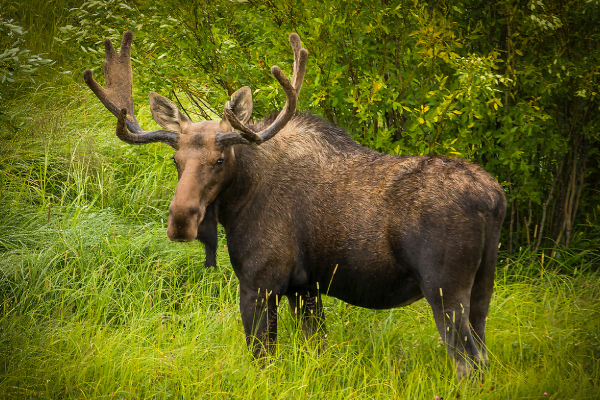 A moose encounter may not be an issue. A dog off leash encountering a moose could create a problem for the moose, the dog, or the dogs owner.
A moose encounter may not be an issue. A dog off leash encountering a moose could create a problem for the moose, the dog, or the dogs owner.
When a problem is identified it does not always result in a closure. A good example of that is the Dowd Junction deer underpass study. It showed that having the bike path open during deer spring migration impacts the migration. The solution was not a closure of the bike path. The result was a visual barrier that is put up each spring so that the deer could not see the people on the bike path. The result was that the deer continued to migrate unimpeded. It is interesting that the deer migrated more or less undisturbed by heavy vehicle traffic for many years but when the people were out of their cars on the trail the deer were impacted.
Various organizations are installing cameras to monitor the sensitive trails and areas. These cameras can inform managers about how and what wildlife is using an area and what humans are doing in those areas. They can also provide data points on the number of animals and the total usage by humans. Cameras also tell the story about how well humans adhere to the existing closures.
Many clubs for various types of outdoor recreation are getting involved to help protect their sports. Those clubs understand that irresponsible use of areas may result in closures and restrict their ability to recreate in many places. They provide their members with information about closures and what activities and practices will keep them safe and cause little or no harm to wildlife and the environment. Groups that do this recognize that being involved in responsible environmental action will help to reduce negative attitudes some people may have about their club’s activities.
Citizen scientists, volunteers, trail ambassadors are becoming more involved. They patrol trails and work at trailheads to help monitor the area and contact the public to provide educational messages. This also includes safety messages about situations that the public may be unaware of.
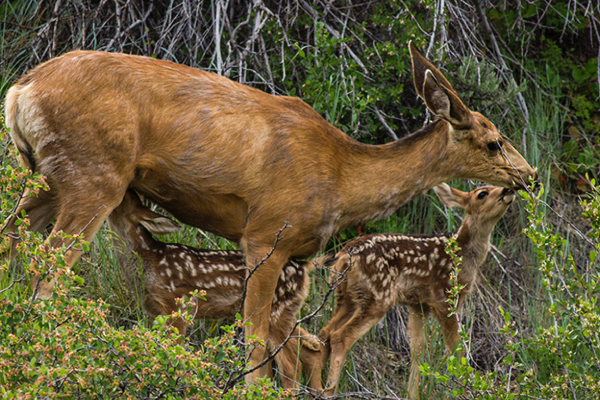
Wildlife that is frequently disturbed by humans may have difficulty providing enough nourishment for their young.
Signs, fences, and barricades are set up to inform recreationalists about the various closures. Those signs usually have an explanation that includes the reason for the closure and the time frames involved. These signs are a necessity because various management organizations and law enforcement agencies simply cannot provide the manpower to watch over the 1,692 square miles in Eagle County.Organizations like the Eagle County Community Wildlife Roundtable have been established to rally community support around issues that will initiate positive action and long-term solutions for the wildlife in our area. A website, supported by Walking Mountains is being designed that will have resources available to help people recreate responsibly.
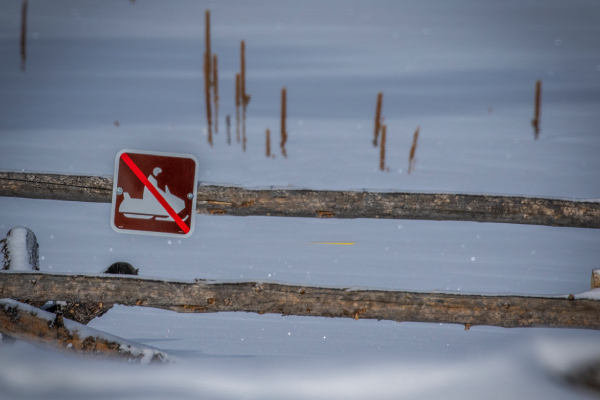 Snowmobiles often don't follow trails and can enter large areas that are closed as Critical Wildlife Habitat.
Snowmobiles often don't follow trails and can enter large areas that are closed as Critical Wildlife Habitat.
The Vail Valley Mountain Trails Alliance (VVMTA) is the leading advocate for soft surface trails in Eagle County, CO. They promote stewardship of our public lands, sustainable trail building practices, and a balance between recreation and conservation. The VVMTA maintains that trails contribute to the quality of life and economic vitality of the community. In an effort to mitigate our declining wildlife population, in 2018 the VVMTA, in partnership with the Holy-Cross Ranger District, launched its Wildlife Trail Ambassador program. The program includes Field Ambassadors and Social Ambassadors who educate and inform trail users as to why seasonal closures exist, offer education about local flora and fauna, and spread the ‘Leave No Trace” principles. Since the program inception, over 600 volunteers have contributed over 800 hours of their time at seasonally closed trailheads educating and deterring users from recreating in the area. They maintain a web page with trail closure information. To help protect wildlife and educate trail users about seasonal wildlife closures consider volunteering as a Wildlife Trail Ambassador. Their training for the winter closure season is on December 8th. Visit vvmta.org to learn more.
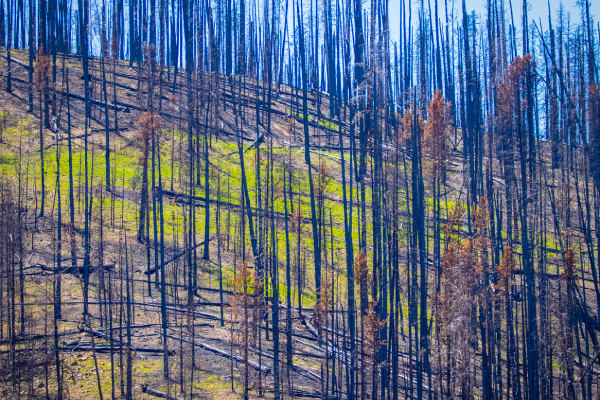 After wildfires and area may be closed to protect visitors from falling trees, burned out tree hollows, and downfall.
After wildfires and area may be closed to protect visitors from falling trees, burned out tree hollows, and downfall.
Please do your part and respect the closures as they occur to protect the environment and wildlife that we all enjoy.

Rick Spitzer is the author of the article and official photographer for Eagle County Community Wildlife Roundtable.
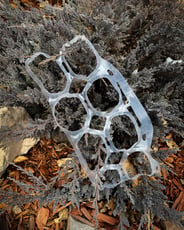

Text and photos by Rick SpitzerThe wildlife around us encounter many hazards. Most are...
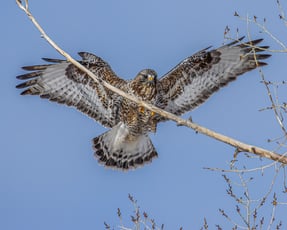

This year I have become even more convinced that much of the wildlife in Eagle County and other...